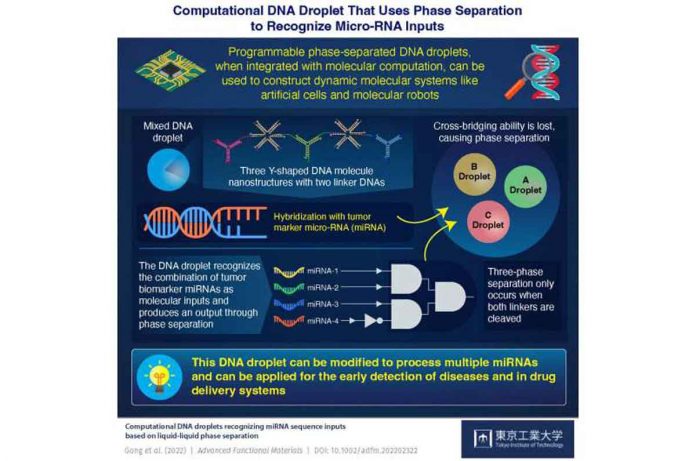The production of aqueous droplets in macromolecules by liquid-liquid phase separation (or coacervation) is a hot topic in biosciences study. DNA is particularly interesting among the different macromolecules that form droplets because it is predictable and programmable, both of which are desirable properties in nanotechnology. The programmability of DNA has recently been used to build and govern DNA droplets created by the coacervation of sequence-designed DNAs.
Prof. Masahiro Takinoue’s team at Tokyo University of Technology (Tokyo Tech) has developed a computational DNA droplet that can distinguish certain combinations of chemically generated microRNAs (miRNAs) that act as tumour indicators. Through physical DNA droplet phase separation, the droplets can produce a DNA logic computation output using these miRNAs as a molecular input. Prof. Takinoue explains why such research is necessary “The use of DNA droplets in cell-inspired microcompartments has been documented. Despite the fact that biological systems regulate their functioning by combining biosensing with molecular logical computation, there is no literature on DNA droplet integration with molecular computing.” Advanced Functional Materials published their findings.
A number of experiments were performed to create this DNA droplet. To construct A, B, and C DNA droplets, scientists first created three types of Y-shaped DNA nanostructures termed Y-motifs A, B, and C, each having three sticky ends. Similar droplets tend to stick together naturally, whereas different droplets require the use of a particular “linker” molecule. To connect the A droplet to the B and C droplets, they used linker molecules, which were referred to as AB and AC linkers, respectively.
They tested the “AND” action in the AB droplet mixture by introducing two input DNAs in the first experiment. The presence of input is recorded as 1 in this procedure, while its absence is recorded as 0. The phase separation of the AB droplet mixture occurred only at (1,1), that is, when both input DNAs are present, indicating that the AND operation was successfully applied. Following this research, the researchers chose to add breast cancer tumor markers miRNA-1 and miRNA-2 to the AC droplet mixture as AND inputs. The AND operation worked, indicating that the computational DNA droplet was able to identify the miRNAs.
The team showed simultaneously AND and NOT operations in the AB mixture with miRNA-3 and miRNA-4 breast cancer biomarkers in later studies. Finally, they made an ABC droplet combination and added each of the four breast cancer indicators to it. The phase separation in an ABC droplet was determined by the cleavage of the linker, which resulted in a two-phase or three-phase separation.
The ability to identify a set of recognized cancer biomarkers or markers for three diseases at the same time was demonstrated by the ABC droplet’s characteristic. Prof. Takinoue, who is also the corresponding author, believes that computational DNA droplets have enormous promise. He asserts that “We can use a DNA droplet that can combine and process many inputs and outputs in early illness diagnosis and medicine delivery systems if one can be produced. Our current research also serves as a springboard for future work on artificial intelligence and molecular robotics.”

